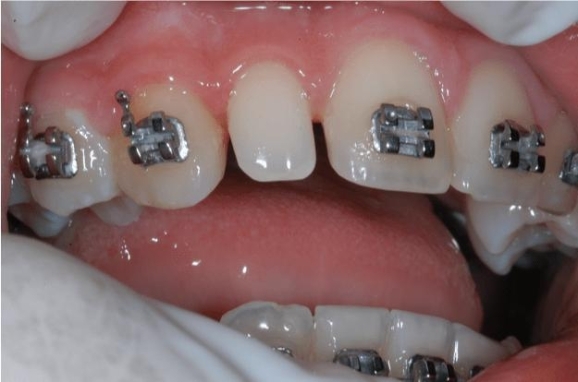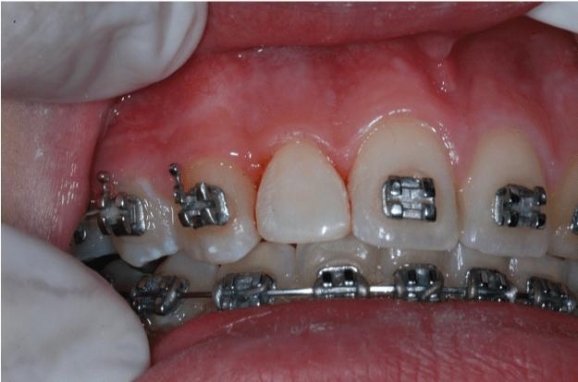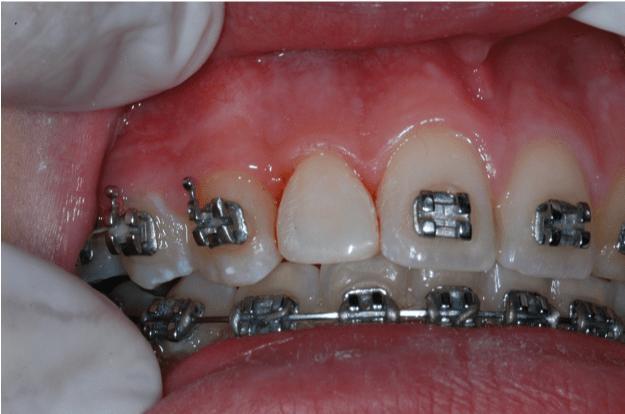Esthetic restorations in pediatric dentistry: a recent case
What are esthetic restorations of teeth?
An esthetic restoration is a type of dental reconstruction that seeks to improve the appearance of the smile.
Therefore, one of the most common treatment options is an aesthetic dental treatment to:
a) recover dental structure and
b) improve functionality of affected teeth.
In addition, it recovers and even improves previous aesthetics at the same time.
What is aesthetic restorative dentistry?
Clearly, aesthetic restorative dentistry is the type of dental restorations that seek improving the smile of patients.
The reasons that may cause the need for a smile restoration procedure are:
Dental fracture caused by a trauma.
Oral trauma is common in children and adolescents, mainly affecting anterior teeth.
For the younger ones, as they learn to walk, run and climb everywhere they can, it makes it easier for them to fall. Therefore, it is only necessary to go to a playground to witness blows and falls that affect the teeth.
In addition, as they get older, boys and girls have more sports accidents. The most common sports causing this problem are skiing, soccer, basketball, field hockey and falls in swimming centers.
Caries process.
Today, thanks to increased knowledge and better prevention practices, caries ocurrences are less common than in the past century.
Daily hygiene with fluoride toothpaste and even better, with adding the use of floss, we prevent caries in incisor teeth. Cases of nursing caries are also less prevalent today because prevention has improved among families.
What are the esthetics parts of dentistry?
The esthetic restorations of teeth can be:
a) alterations of tooth coloration
Such as hypo-plasias:
A yellowish enamel condition where the tooth enamel is thin and is less mineralized. It can be present in all the teeth or just in one. Also, it may affect baby teeth and permanent teeth.
Or hypo-calcifications:
Which is an opaque enamel defect where the tooth enamel has less amount of calcium. This can make the teeth more prone to fractures and caries, because of its thickness and weakness. Generally, this type of teeth present white, brown or yellow spots.
b) shape and/or
For example, when the natural teeth have altered shapes such as conical teeth. In this case, the use of aesthetic restorations will help to give a more symmetrical shape to the teeth using a less invasive technique. Clearly, microdontia might accompany this condition (as we will explain later) in one or several teeth.
c) different size of a tooth structure
Microdontic teeth:
These are clinical cases in which the teeth are smaller than they should be. Therefore, a microdontic tooth occurs when it measures smaller than expected compared to the other teeth.
Macrodontic teeth:
In this case, the teeth are larger than they should be in comparison with the rest. Because of this condition, we reshape these teeth like the other ones while kepping their functionality and anatomic similarities.
On other occasions, they have structural defects such as in amelo-genesis or dentino-genesis. With no doubt, both of these conditions may cause teeth sensibility.
Amelo-genesis:
On one side, amelo-genesis is a genetic condition that affects the enamel development of teeth. In this case, the enamel is thin, porous and yellowish.
Dentino-genesis:
On the other side, dentino-genesis is a hereditary condition that affects the development of the dentin in teeth. In this process, the teeth look opaque and brownish.
What is an aesthetic dental treatment?
Examples are those that modify the position, shape and/or color of the teeth affected by:
a) pathologies or
b) pre-existing alterations.
Dentists perform most smile designs using esthetic composite resins for the restorations. These materials improve dental esthetics and preserve dental structure and health.
They can reproduce angles of damaged or fractured teeth, incisal edges, or even fractures that reach the gingival margin.
Occasionally, especially when there are large stains and staining by:
a) severe hypo-mineralizations,
b) amelo-genesis or
c) dentino-genesis,
Therefore, the dentist can perform esthetic dental veneers on the affected teeth, so they can achieve high esthetic standards. These would be the most conservative treatments.
Also, there are other restorative options such as:
a) zirconium or porcelain composite veneers,
b) zirconium or porcelain crowns, or
c) implant-supported prostheses.
Undoubtedly, these options are no longer as conservative as reconstructions with esthetic resins. Importantly, we indicate every technique in concrete cases. Although, they are not the best options to preserve the greatest amount of tooth enamel.
Specific cases indicate every technique. Whatever the technique used, patients should keep an excellent oral hygiene (less risks of gingivitis and dental decay). Clearly, apart from teeth and gums, it also helps to maintain his/her prosthetic restorations clean.
What are aesthetic restorative materials in pediatric dentistry?
Dental Composites for esthetic restoration
Most used material in pediatric dentistry for its great aesthetics and easy placement.
Resins for Interim therapeutic restoration (ITR)
To prevent the progression of caries without using local anesthesia. The use of this technique will depend on:
a) the patients´ age,
b) the pediatric dentist’s criteria determine which tooth to treat, and
c) the patients´ behavior during the dental appointment.
Resins for resin infiltration
Many dentists consider resin infiltration a good esthetic long-term solution to repair large stains in the front teeth. Sometimes, depending on the tooth defect (larger and deeper stains), we need a more invasive approach.
Resins for Atraumatic/alternative Restorative Technique (ART)
ART serve as a kind of temporary therapeutic restoration primarily for teeth that are about to exfoliate.
Glass Ionomers
Among them we can use:
a) Conventional glass ionomers
b) Resin modified glass ionomers
c) Glass ionomer sealants
Pit and fissure sealants
These kinds of resins are used to prevent cavities in posterior teeth (molars). Easy to use, they can help patients improve their oral hygiene. This is especially true for hard-to-reach areas.
How is a dental restoration performed?
Everything will depend on the type of problem we have and what we want to improve to recover function and esthetics. The treatment for esthetic restorations of teeth includes several steps to follow.
Steps to follow:
1. Treatment planning
Once defined, it will be easier for the Pediatric Dentist to find a solution. Also, to explain the procedure to the patients and their parents.
2. Color matching
Pediatric dentists must match the color of the tooth they will restore with the adjacent tooth. Especially in anterior teeth because of their high esthetic need.
3. The use of rubber dam
The dentist needs the rubber dam to isolate the tooth for restoration. This will prevent contamination of our final restoration with saliva.
4. Finishing and polishing
this way the restorations are going to look more natural and facilitate its cleaning for long term results.
Materials to use
As explained earlier, pediatric dentists use kinds of materials for esthetic restorations depending on each case and indication. The choice will depend on the tooth to restore. In any kind of treatment, the pediatric dentist must consider the patients’ needs.
Finally, not all patients require the same therapeutic solutions. So, you need to carefully choose the restorative material and technique.
In worn teeth
When dealing with worn teeth, dentists must choose restorations that can withstand the forces of chewing. Therefore, pediatric dentists will not always choose what looks nicer. Clearly, they also need to focus on what works functionally in these cases. Current materials are highly resistant to dental wear of enamel and dentin.
For an esthetic restoration problem
If we are looking to solve esthetic problems, we can use of resin restorations and composite restoration veneers. All this, with the addition of help by “opaquers” so that the color of deeper dental layers does not show through.
Undoubtedly, the minimally invasive materials and techniques will vary depending on each case. Dentists can use esthetic porcelain or zirconium crowns, or prostheses on dental implants.
The important thing will always be to seek oral health as the primary objective. And, respecting this principle, to achieve the best esthetics.
Is cosmetic dentistry the same as restorative dentistry?
Clearly, the objective of esthetic restoration procedures is to improve the functionality of teeth and address oral health issues. On the other hand, cosmetic dentistry aims to address the appearance of gums and teeth to create a pleasing smile.
What is an example of esthetic dentistry?
In this case, the patient had a microdontic upper lateral incisor (smaller than usual size).
The lateral incisor is smaller than the central incisor, but it must keep an esthetic and functional proportion. In the present case, it is much smaller than it should be. However, the tooth does not present a great alteration in shape. Its configuration is only slightly more rectangular than it should be.
After the orthodontic treatment, the dentist decided to use dental esthetic composite. In this way, we were able to give it the same shape as the tooth on the opposite side. Finally, this way the patient obtained an harmonious, esthetic and healthy smile.
As shown below, the difference between the teeth before and after esthetic restoration dental treatment is notorious. Our skilled team at BOJ Pediatric Dentistry Clinic in Barcelona helps children and young patients get their best smile. This is synonymous with health and family well-being.
Photos before and after the esthetic restoration
Photos before and after the restoration of the lateral incisor after finishing the orthodontic treatment in our dental clinic. Clearly, after the treatment, it looks like a natural tooth:


References








